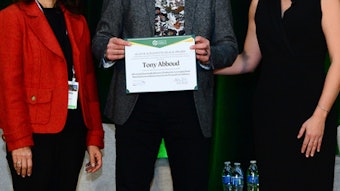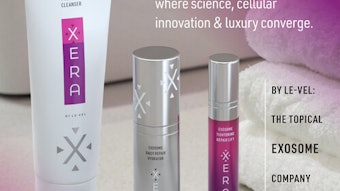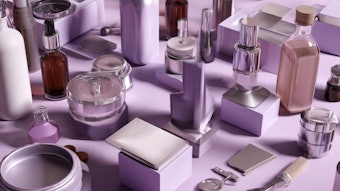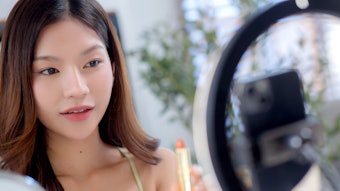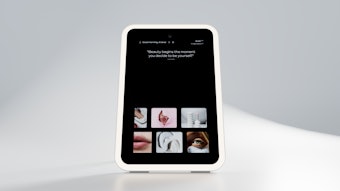Science, philosophy and evolution have ushered in a new and long overdue perspective on aging. Considering the size of the baby boomer market, the influences of cultural diversity and the predictable power of a historically momentous generation to effect change, is it any wonder perspectives are shifting? It has been said “50 is the new 30,” and ad man Donny Deutsch (The Big Idea, November 10, 2006) has said, “Take age off the table and extend your brand.” This implies that the future is the focus—don’t look back. Taking that sentiment at face value, clearly the face of aging is being redefined, and today’s beauty marketers, at the center of this story, are partially responsible.
The power of the particular demographic around which the entire antiaging category centers cannot be underestimated. Characteristically, the boomer generation hasn’t remained silent and demure about anything, and aging skin, less than perfectly taut and toned bodies as well as graying manes cannot reduce this segment of the population to invisibility. One glance at the movers and shakers in the beauty industry finds incredibly talented, frequently seasoned professionals at the helm. And while the silver screen may be largely inhabited by ingénues, icons of Hollywood, politics, theater, music, art and literature are increasingly those whose beauty exemplifies lives well-lived.
Worldwide, the forecast market for antiaging and nourishing products in the year 2010, is expected to be $15.8 billion. The current world figure for antiagers and nourishers is $11.3 billion (as of 2005), not an insignificant sum. An evolved approach to tapping into this demographic is stirring the imaginations of marketers and stimulating consumer spending.
Media Offers the Message
More magazine has featured Susan Sarandon, looking fabulous at 59, and Sharon Stone, “Fiery at 48,” on its cover—providing a defining perspective on a generation of women who are empowered, confident and resourceful. Lois Joy Johnson, beauty and fashion director, More, offered these insights into the new face of beauty.
On marketing to consumers over 40, Johnson said, “Products that target the skin, hair and makeup concerns of women (over) 40 have been around for decades, but the dramatic increase in the number of products available at every price point shows just how powerful this consumer demo is to beauty brands. The intrigue about what’s new and what’s best never slacks as thousands of new antiaging options a year get our attention.”
Johnson notes that product appeal has moved beyond basics. “If it firms, brightens, smoothes, fills or plumps we’re interested. If it has antioxidants, botanicals and increases ‘glow’ or radiance, we’re ready to plunk down our credit cards. Even categories like shampoos, conditioners and hair color have moved beyond basics and are packed with vitamins and botanicals that counteract thinning, chemical processing and heat styling. There has been an expansion of luxury products from brands such as Estée Lauder, Chanel, La Mer and Dior for this consumer, who has the money to afford pricey products like face creams for $350 and upward if she chooses. Dermatological and spa procedures like microdermabrasion, peels, hair masks, tooth whitening kits, body polishers and wrinkle relaxers are part of the at-home arsenal now and appeal to time-crunched women who work and want to maintain their looks easily,” said Johnson.
Women today are celebrating their individuality, empowerment and confidence, with beauty that goes way beyond a one-dimensional definition. Johnson adds, “When it comes to advertising, nothing gets our attention better than our peers, so it’s no surprise that 40-plus celebs are the newest, hottest faces for ad campaigns. As long as the attitude and image is age celebratory and the message is ‘we’re clearly not trying to look 25 again,’ we love it.”
Revlon got things rolling with Susan Sarandon and Julianne Moore, and now Sharon Stone is a face for Dior; Diane Keaton, 60, for L’Oréal Paris; Christie Brinkley, 52, for Cover Girl; and so on. You’re not seeing 25-year-olds selling wrinkle creams anymore. It’s reassuring, too, that most of these celebs are imaged in a realistic way. Keaton, for example, is not retouched for her L’Oréal Age Perfect ads. The positive response from women to her ads has been overwhelming.
In May 2006, L’Oréal Paris signed Academy Award-winning actress Keaton to an exclusive contract as a spokesperson for the company and its brands. Keaton said, “I love that L’Oréal is found all over the world and is made for women of all ages, and for women of all skin and hair colors.” The message is inclusive and empowering. Coming from a woman who has won accolades as a performer, director and producer, it communicates both success and authenticity.
The TV ads, which feature Keaton in her signature white pantsuit, show the 60-year-old speaking directly to the viewer, sharing her beliefs in aging authentically and using L’Oréal Age Perfect Pro-Calcium Moisturizer to make her skin resilient, more toned and redensified.
“We have had an incredible response from so many women to the news that L’Oréal signed Diane Keaton as a spokesperson,” said Carol Hamilton, president of the L’Oréal Paris division of L’Oreal USA, Inc. “Diane is an exemplary role model for women in every stage of their lives, and especially for women of her generation. She possesses such a luminous beauty and personality, is incredibly smart and truly cares about how women feel about themselves.”
“Advertising is gearing more toward the 40-plus market in the beauty and health arenas, and there has been a real need created by the market,” said Johnson. “Our readers tell us they have never looked better. Most say they never looked this good in their 20s or 30s—and the reason is a focus on nutrition and fitness, better skin care and the self-knowledge and confidence that comes with age.”
Redefining Beauty
Cosmetic companies—including Estée Lauder, L’Oréal, Beiersdorf, Cover Girl and Clarins—are part of a progressive environment that surrounds the marketing and promotion of “The New Face of Beauty,” and products addressing aging skin have gone hand in hand with the personification. Beyond technology and scientific research, however, is the positioning of a product and brand, and the emotional connection that is created with consumers.
On its Web site, Beiersdorf, for example, combines the image of a vibrant, mature woman with research documentation to present a total picture of its latest innovation in antiaging—Nivea Visage DNAge Cell Renewal. A welcoming tag line reads, “Rejuvenate your skin from within. “Getting older is a fact, looking older is now history.” Nivea Visage DNAge Cell Renewal is a system of day, night and eye care products targeting rejuvenation. The formulas contain cell-active folic acid and creatine to stimulate cell renewal from within, protect against future damage and leave skin firmness noticeably improved. Researchers at Beiersdorf say folic acid is involved in DNA synthesis and cell turnover. “The human body cannot produce (folic acid), we must get it from food,” according to Beiersdorf.
From Functional to Fantastic
Caroline Pieper-Vogt, senior vice president of marketing, Clarins USA, notes the importance of looking at this consumer and understanding what she is experiencing at this time in her life.
“We take into account the needs of her skin and the physiology of skin at a mature age. We also look at her emotional needs and her lifestyle preferences. Her needs in these areas are certainly different than when she was younger, and we take them into consideration when it comes to formulations, packaging, product texture and size,” she said.
The customers Clarins addresses are within three different maturing age groups—women in their 30s, 40s, and 50s-plus.
“The skin is extremely different at these stages, and women see themselves very differently in these decades,” said Pieper-Vogt. “With our antiaging products, we delineate first by a woman’s age and then by a specific need at that age. Needs become more specific with age and our products become more targeted as well.”
For example, Clarins Line Prevention category is formulated for women in their 30s, Extra-Firming is targeted to women in their 40s and the Super Restorative line is designed for women in their 50s and those beyond.
“This category also treats very specific concerns that are relevant only to this age group,” notes Pieper-Vogt. “We recently launched Super Restorative Redefining Body Care, which targets the midsection, as the abdomen and waist area tend to lose their shape as we mature. We developed this product to provide a smoother, firmer, more streamlined shape.”
While Clarins doesn’t have one particular spokesperson for the brand, their advertising visually represents their insights into this category.
A spokesmodel who captured the attention of baby boomers and has journeyed along with this generation, Christie Brinkley graces the CoverGirl advertising for Advanced Radiance Age Defying Liquid makeup, which states simply, “Look as young as you feel.”
“Many women over 35 now seek antiaging and moisturizing as the primary benefits of their foundation,” said Esi Eggleston Bracey, vice president and general manager, North America, Procter & Gamble. “However, they may not realize with traditional age-defying makeup, they have to trade radiance in order to minimize their skin’s imperfections and vice versa. Advanced Radiance Age Defying Liquid Makeup meets women’s needs with a one-of-a-kind dual approach—boosting brightness while also reducing the look of shadows, fine lines, discolorations and wrinkles. The overall effect is radiant skin instantly looking five years younger.”
Every Woman Can Be Beautiful
In the immortal words of Estée Lauder, “Every woman can be beautiful,” and, indeed, that is the leitmotif of the Lauder beauty philosophy. It has served millions of women well, and continues to weave its magic for women in any and every stage of life.
According to Marjorie Lau, vice president marketing, Estée Lauder North America, “Beauty is not about chronological age.” Lau states that the Lauder core customer is over 35, and the focus is more on health, feeling good and looking your best at any age.
Consumers are diverse, and while some select “basic” cosmetics, others have more complex needs. Lauder products are designed to address those needs. “It all has to do with a person’s attitude and how they define aging for themselves,” said Lau.
In keeping with the company philosophy, Lau noted personalizing service and products are key strategies employed by the Lauder Companies.
A new online strategy that supports the launch of Advanced Night Repair Concentrate Protective Recovery Complex offers women an opportunity to share their beauty secrets. “Our goal was to launch a new product, Advanced Night Repair Concentrate, and reinforce the strong heritage of the existing franchise with an interactive program that would facilitate a word-of-mouth campaign among women. Today, more than ever, the success of a beauty product is dependent on women sharing their beauty secrets,” said Lau.
The Lauder’s www.thelittlebrownbottle.com site was launched in September 2006. Visitors will find history, customer testimonials, product information and tips on ways to relax and renew themselves. In addition, the final component of the Advanced Night Repair Concentrate online marketing campaign will be a media buy across a variety of Web platforms—including The New York Times, AOL and www.style.com. The Estée Lauder brand also has reached into the “blogosphere,” and secured ad space on www.myfashionlife.com, www.agingfabulous and www.mommieswithstyle.com—in keeping with the company’s “lifestyle orientation” for women of all ages in the global community.
Exploring the marketing messages of these top brands has revealed a striking consensus. Women of all ages are not only unique and beautiful, but are entitled to their dreams, aspirations and accomplishments. As the L’Oréal message reiterates, “Of course, we’re worth it,” and despite outdated sentiments relegating women of a certain age to relative obscurity, the new face of beautiful aging has emerged with a new face of confidence. Women, regardless of age or interests, form a beautiful, global community. Although new technology, innovative products and positive marketing have validated that perception, everyone knows that true beauty still comes from within.



